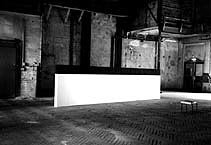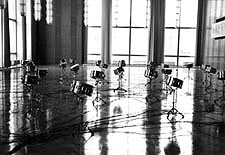

Hans Peter Kuhn: Ballett
Ulrich Eller: Snare Drums
Sonambiente Festival for Eyes and Ears |
KAWASAKI Yoshihiro (artist) |
Sound / Environment : The Realization of a Great Experiment in Berlin | |
 |
 |
Hans Peter Kuhn: Ballett |
Ulrich Eller: Snare Drums |
Sound and Installation : Laurie ANDERSON, Sam AUINGER/ Bruce ODLAND, Andres BOSHARD, Nicolas COLLINS, Paul De MARINIS, Louis-Philippe DEMERS/ Bill VORN, Ulrich ELLER, Brian ENO, Terry FOX, Paul FUCHS, Hans GIERSCHIK, Gün, Josefine GÜNSCHEL, Felix HESS, Gary HILL, Stephan von HUENE, Robert JACOBSEN, Arsenije JOVANOVIC, Rolf JULIUS, Christina KUBISCH, Hans Peter KUHN, Ron KUIVILA, Bernhard LEITNER, Alvin LUCIER, Christian MARCLAY, Robin MINARD, Gordon MONAHAN, Max NEUHAUS, Ed OSBORN, Roberto Paci DALÒ/ Isabella BORDONI, Nam June PAIK, Paul PANHUYSEN, Yufen QIN, Martin RICHES, Don RITTER, David ROKEBY, Nicola SANI/ Mario SASSO, Sarkis, Leo SCHATZL, Kyra STRATMANN, SUZUKI Akio, Ana TORFS, Trimpin, Peter VOGEL, Red White and Young Farmer's Claim Future ........ |
Performances, Concerts, Sound Theater : Henning CHRISTIANSEN, Achim Freyer Ensemble/ Alvin CURRAN, Paul FUCHS/ Zoro BABEL, Matt HECKERT, Fatima MIRANDA, David MOSS, Wolfgang RIHM/ Klaus vom BRUCH/ Ensemble 13, Dieter SCHNEBEL, Laetitia SONAMI, Mark TRAYLE and WADA Junko/ Hans Peter Khun.......
|
Sites in the city included an old building used by the Academy of Arts in the former East Germany, an old building that stands on the grounds of a massive Daimler-Benz construction site, a meeting hall in the former East Germany, and a post office building, also in the east, for a total of over 24 separate spaces. I received a ticket allowing me to enter all of the sites and a pamphlet (including profiles of the artists, a schedule, and a newspaper clipping with all of the site locations crammed onto it--and only in German at that) I carried with me as I made my way to each of them. As I trudged through the city on foot, or took advantage of public transportation systems such as the U-bahn and double-decker buses, I felt like a tourist busily sightseeing while being careful not to lose track of the closing times at each of the sites. There are probably some readers who have had similar experiences, but even by making a fairly serious (?) effort to get everywhere on a two- or three-day schedule and taking your time to listen to everything, upon repairing to a cafe for a cup of coffee and thinking back on what you've seen, it inevitably turns out that you've overlooked something or other (even though you were able to get around to see everything at the Documenta Festival, and it too was unbelievably large). Then since you are also going out to a concert or performance at night, having the physical strength to do everything begins to be a real problem |
| . | Next, let me introduce a few of the major works at the festival. At an old building called the Winehaus, located inside a construction site, there was an exhibition of plan sketches and texts for all of Max Neuhaus's works to date (unfortunately, without any of his sounds). However, Christina Kubisch sampled the construction sounds to create a work that was affected by the noise level outside (when the sampled sound stopped, the sounds outside could be heard through the walls). The roof of the building was set up so that you could experience the physical sensation of the massive construction site, and look 360 degrees around at the scene. On one side of the Brandenburg Gate, in the old Academy of Arts building, which seemed ready to collapse at any minute, Terry Fox exhibited a work that consisted of the sounds of drops of water falling into a wash bowl, and onto potted plants, eggs, sponges, and a heater. Laurie Anderson had hung big a disk that looked like a flying saucer with lots of speakers attached to its bottom, and over the multi-speaker system a recording of one of her pieces at was played to give the space a science fiction-like atmosphere. In the large, authoritarian assembly hall in the former East Germany, one of Nam June Paik's multi-screen works faced a gigantic, completely red piece of stained glass depicting a group of workers. In the large hall, Ulrich Eller had set up a work using 30 snare drums that played automatically and continuously. Brain Eno showed a work using multi-slide projectors to create a design that slowly changed. In the remains of the old post office building near the shopping district in the former east, Paul Panhuysen exhibited one of the works he is well known for using wires and a piano. Felix Hess showed a work in which sound changed due to the changes in light, and Yufen Qin showed a beautiful work that used bamboo. In the old, destroyed dance hall, Hans Peter Kuhn had set up a splendid work with a sharp structure and theatrical sound. Alvin Lucier used the shape of the room to increase the bass sound emitted from speakers under boards that vibrated on oil drums in a delicate and exceptional work (although some vibrated well,others didn't.) Rolf Julius had set up a work that resembled a moss garden with a piece of iron in a forest that was located a short distance away. Of course, it would be impossible for me to introduce each of the numerous works here, but I do want to say that they weren't all by the more famous members of the sound art world; there were also works by many younger German artists. The media paid special attention to a work by Don Ritter that created tremendous sounds in the room next to Alvin Lucier's piece. It was a simulation with the sound of a moving car on a totally black road that would come to a screeching halt whenever a person tried to cross the room. I'm not quite sure why it attracted so much attention, but perhaps it was easy for common people to understand (?), and was memorable for allowing them a kind of hands-on experience. At any rate, it was a fairly straightforward piece. |
| In an interview with Matthias OSTERWOLD, the organizer of the festival, I asked him why he hadn't held the event in a museum. He answered, "First, there isn't a museum big enough in Berlin to do it, and besides, art isn't made for museums." (In fact, there are some buildings comparable in size to Japanese art museums where the event could probably have been held.) Needless to say, one of the most important themes of the festival was "environments." And Matthias and the other organizers undoubtedly wanted to present works in the city of Berlin as it is today. In his words, "Creating sites within the city--that's one of the goals of this project." This didn't simply mean securing a certain space, but was connected to three key concepts that may help to better understand the festival and how the artists were chosen: 1) "only living artists," 2) "new work," 3) "in the situation." To him the word "site" refers to a place that is created by living artists who make new works that fit the situation (in the widest sense of the word), and form a connection with the people who come to visit the space. All of these elements form a "site," and all of these words give some idea why an art festival of this sort was held in Berlin at this point in time. | ||
| Big changes in history and the world situation have occurred since the Berlin Wall was destroyed, and the city of Berlin seems to be headed toward even greater change. Currents in modern art that began at the turn of the century also seemed to be dovetailing with sound art, in its present position on the cutting edge, at the festival. When I asked Matthias why he had chosen sound art as the focus of the festival, he spoke for a long time on the history and vicissitudes of modern art and the place sound art occupies within it. "Perhaps it would be better to call it 'art with sound'....It is what comes next after visually oriented culture....Composers, visual artists, dancers, performers, and people from a variety of fields have been working together to create new art, and this is now going through new developments....This will be something that has a stronger relation to its situation....There will no longer be any need for specialists to listen to this work....It will enter our ears more directly than ever." Through these comments, it is clear that he is trying to discover new possibilities and experiments. Sonambiente itself may have been a kind of giant experiment set up in the city of Berlin. At the end of our conversation, he listed three works as symbolic examples of the future. One was Ulrich Eller's thrilling acoustic piece (the drums reminded me of the military) in that hall in the former East Germany, Suzuki Akio's (my spiritual older brother) soundscape-like work that left its footprints (people stood on these to hear the sounds around them) in the city, and Henning Christiansen's Fluxus-like piece that lasted for six hours (the music was by Christophe CHARLES, and the piece included art cooking (?) so that people could drink and eat as they experienced it). |